Research Article 
 Creative Commons, CC-BY
Creative Commons, CC-BY
Carcinoma of the Faacial Skin among Yemenis; (A Prospective Hospital-Based Study)
*Corresponding author: Ali Ali AL-Zamzami, Consultant of oral and maxillofacial surgery, Head of the consultant unit of head and neck surgery, AL-Gemhori Teaching Hospital, Yemen.
Received: June 19, 2019; Published: July 26, 2019
DOI: 10.34297/AJBSR.2019.04.000791
Abstract
Objective: The study aimed to study facial skin carcinoma among Yemenis to determain, the types, sites, the relation of this disease to the age and gender, and to define the possible risk factors associated with development of facial skin carcinoma.
Material and Methods: The study is a prospective descriptive hospital based- study carried out at Al-gomhori –Teaching Hospital in Sana’a Republic of Yemen. The material consisted 126 cases of Yemen patients who attending to the department of oral and maxillofacial surgery and to the consultant unit of the head and neck surgery and diagnosed clinically, radiographically and histopathologically as having facial skin carcinoma. Patients who had previous treatment (surgical, radiation or chemo - therapy) or who had recurrent cancer were excluded. Data: were collected from history (using a questionnaire sheet), clinical examination of patients and from the histopathology results of the biopsies. Data were analysis using Statistical Package for Social Science (SPSS).
Results: In this study, 126 cases were reported, 81 cases (64.3%) were males and 45 cases (35.7%) were females, male to female ratio was 1.8:1. Carcinoma of the Facial skin is still remaining the disease of elderly patients, particularly those who have history of long-standing exposure to sunlight. The patients age was ranged from 8 to 92 years, the mean age for both genders was 64.29 ± 15.33 years. The majority of patients (95%) were over the age of 40 years. Basal cell carcinoma was the communist type, accounting 74.6%. Sqaumous cell carcinoma was the second type of facial skin carcinoma, accounting 25.4%. Naso-labial region and infera-orbital region were the most involving sites, accounting 20.6% and 19.8% respectively. Outdoor works (long-standing exposure to sunlight) was the main risk factor that play an important role to developing 68.1% of basal cell carcinoma and 75.0% of sqaumous cell carcinoma.
Conclusion: Carcinoma of the facial skin in Yemen as in all countries still remains the disease of the elderly patients, 95% were over the age of 40 years. Males were affected more than females. M: F ratio was 1.8: 1. Basal cell carcinoma was the most common type, accounting 74.6%. Naso-labial region and the naso- labial region were the most involving sites, accounting 20.6% and 19.8% respectively. Prolonged exposure to sunlight (outdoor work) was the main risk factor that play an important role to development of facial skin carcinoma among Yemenis.
Keywords: Skin cancer; Carcinoma of the facial skin; Basal cell and squamous cells of the face
Introduction
Cutaneous carcinomas (which include, basal cell carcinoma and squamous cell carcinoma) are the most common type of skin cancer in human, usually develops on the sun-exposed region of the head and neck p [1-3]. According to Alam M, Ratner D, basal cell carcinoma and squamous cell carcinoma were the most common type of skin cancers in the head and neck region, accounting 80 % and 20% respectively [2]. Winkel horst and colleagues found that, the incidence of facial skin carcinoma is increasing significantly over the last few decades. The reasons for this increase are not fully clear. However, longevity, changes in behavior in relation to sunexposure and carcinogenesis are suspected [4]. According to WHO, basal cell carcinoma defined as, locally invasive, slowly growing tumor which rarely metastasize, arising in the epidermis or hair follicles [5]. Literature studies showed that, basal cell carcinoma is the most common type of skin cancers and 70 – 80 % of this tumor occurs on the uncovered skin directly exposed to the sun, often observed in the head and neck areas especially the eyelid, nose and peri-oral region [6-8].Basal cell carcinoma is more common in elderly, light - skinned individuals with a family history of BCC and increases in incidence closer to the equator or at higher altitudes. BCC incidence increases with age; about 5-15 % of BCC occur in patients aged 20- 40 years and the incidence is more than 100-fold in persons aged 55- 70 years than in those aged 20 years or younger [6]. Many previous studies showed that BCC is more frequent in the elderly patients, more than 90 % of BCC are detected in patients aged 60 years and older. It’s much greater incidence in males [9- 12].
Many causes are attributed as a risk factors for development of basal cell carcinoma, these includes ; long-standing exposure to son light (combination of cumulative and intensive ultraviolet light exposure), over exposure to x-ray or other forms of radiation, some genetic disorder or syndromes ( such as basal cell nevus syndrome and xeroderma pigmentosum) and immune-suppression therapy [13,14]. Sqaumous cell carcinoma is the second type of non-melanoma skin cancers, arise from the squamous cells of the epidermis, usually develop on sun-exposed surface, often on the head and neck region [15,16]. Squamous cell carcinoma is less common than basal cell carcinoma, account for a proximally 10- 20% of skin cancers, more commonly occurring in the males [1]. Unlike basal cell carcinoma, squamous cell carcinoma is more aggressive and associated with rapidly growth, local invasion, metastases to regional lymph nodes and distance organs such as the lungs and bones [17,18]. Chronic exposure to ultraviolet radiation appears to be the most relevant causes of development of sqaumous cell carcinoma. The occurrence of SCC is associated with total cumulative lifetime UV dose [19-22]. Chronic skin disease or injury (egulcers or sinus tracts), exposure to iodizing or other type of radiations, immunosuppression therapy and genetic disorders or syndromes (such as xeroderma pigmentosa) were other risk factors that play an important role to developing sqaumous cell carcinoma [2,23].
White people older than 50 years of age, living in countries close to the equator or in subtropical zones with a history of extensive exposure to sunlight are most susceptible to developing squamous cell carcinoma of the skin. The most common affected site includes the face, back of the hands and forearms [22,24]. Carcinoma of the facial skin among Yemenis have been increasing in incidence significantly over the last few decades. The reasons are unknown due to the lack of a nation - wide population - based neoplasm registry. Long-standing exposure to sun light may be the most attributed factors, because the majority of Yemeni peoples are outdoor works (such as farmers, fisheries, buildings and another open field). They spent more than 10 hours daily exposure to sun light. The present study aimed to study facial skin carcinoma among Yemenis to determain, the type, site, the type of the disease in relation to age and gender, and to define the possible risk factors associated with development of facial skin carcinoma
Material and Methods
This study design as a prospective, hospital based –study, carried out at AL-gomhori Teaching Hospital (The major referral center of cancer in Yemen) in Sana’s Republic of Yemen. All patients attending to the Department of Oral and Maxillofacial Surgery and to the Consultant Unit of the Head and Neck Surgery and diagnosed clinically, radiologically and histopathologic ally as having facial skin carcinoma were examination. Foreign patients, patients who had previous treatments (surgical, radiotherapy or chemotherapy) or had recurrent cancers of head and neck region were excluded. Data were collected from patient history (using a questionnaire sheet), clinical examination of the patients, radiograph examinations and biopsy results. Histopathological results were used to confirm the diagnosis. Data were entered and analysis with the computer using Statistical Package for Social Science (SPSS). Ethical clearance: The respondent was adequately informed about all relevant aspects of the study including; the aim of the study, the need of investigations, and regular follow up. Privacy of patient is the most of our priority.
Results
A total of 126 cases of facial skin carcinoma were studied, 81 cases ( 64.3% ) were males, and 45 cases ( 35.7%) were females, male to female ratio was 1.8 : 1. The patients age was ranged from 8 to 92 years, the mean age for both gender was 64.29±15.33 years. The majority of patients (95%) were over the age of 40 years. The peak age of occurrence (46.8%) was in the 7th and 8th decades of life (Table 1). Basal cell carcinoma and squamous cell carcinoma were the most common types of non-melanoma skin cancer, accounting 74.6% and 25.4% respectively (Table 2).Of basal cell carcinoma, 94 cases were reported, 58 cases( 61.7% ) were males and 36 cases ( 38.3%) were females, male to female ratio was 1.6 : 1. Patients age was ranged from 8 – 92 years with average of 50 years. The majority of patients (94.7%) were found over the age of 40 years. The peak age of occurrence was in the 7th and 8th decades of life (Table 3). Naso-labial region, infera-orbital region, the nose and temporal region were the most affected sites, accounting 25,5%, 22.3%, 19.1% and 10.6% respectively. The less affected sites were the lip, check, frontal region, canthus and pre-auricular region, accounting 5.3 %, 5.3 %, 4.3%, 4.3 and 3.2% respectively (Table 4). Of squamous cell carcinoma, 32 cases were reported, 23 cases (71.9%) were males and 9 cases (28.1 %) were females, male to female ratio was 2.6:1. Patients age was ranged from 30 – 90 years with average of 60 years. The majority of patients (96.8%) were found over the age of 40 years. The peak age of occurrence was found between 5th and 8th decades of life (Table 5). Check, temporal region, infera-orbital region and pre-auricular region were the most affected sites, accounting 31.3%, 15.6%, 12.5% and 12.5% respectively. The less affected sites were the lip, the nose, naso-labial region and frontal region accounting, 9.4%, 6.3%, 6.3 and 6.3% respectively (Table 6).
According to site distribution of facial skin carcinoma, nasolabial region, infera-orbital region, the nose, temporal region and the check were the most affected sites, accounting 20.6%, 19.8%, 15.9%, 11.9% and 11.9 % respectively. The less affected sites were the lip, pre-auricular region, frontal region and canthus accounting, 6.3%, 5.6%, 4.8% and 3.2% respectively (Table 7). Associated with developing 76.9% of naso-labial carcinoma, 75.0% of lip carcinoma, 73.3% of check carcinoma m 72.0 % of infera-orbital carcinoma, 66.7 % of frontal carcinoma, 65.0% of the nose carcinoma, 57.1% of pre-auricular carcinoma, 53.3% of temporal carcinoma and all carcinoma of canthus region. Trauma, hereditary and radiotherapy were other risk factors that have an insignificant role in the causation of facial skin carcinoma (Tables 8). Outdoor work was the main risk factor that play an important role for developing of facial skin carcinoma. Outdoor work was responsible of developing 69.8% of facial skin carcinoma, followed by trauma, hereditary and radiotherapy accounting 11.1%, 1.6% and 1.6% respectively. There are 20 cases (14.9) of facial skin carcinoma developed without risk factors (Table 8). Out of 125 cases of facial skin carcinoma 88 cases were outdoor workers, 52 cases (41.3%) of them were males and 36 cases (28.6%) were females (Table 9). Outdoor work was associated with the developing of 68.1% of basal cell carcinoma and 75.0 % of sqaumous cell carcinoma (Table 10&11). Outdoor work was
Dissection
The lack of database of the malignant tumor of the face in Yemen, which makes it impossible to give any prevalence values for facial skin carcinoma in this country. This study provides data for comparison with other studies from different countries in the world. In the present study, basal cell carcinoma and sqaumous cell carcinoma were the most common types of facial skin carcinoma, accounting 74.6% and 25.4% respectively. Males were affected more than females, male to female ratio was 1.6:1 for basal cell carcinoma and 2.6:1 for squamous cell carcinoma. These findings are in agreement to report by AL-Zamzami and Suleiman [25] who founds that, basal cell carcinoma and sqaumous cell carcinoma were the most common types of facial skin carcinoma, accounting 72% and 27% respectively. This report also showed that, males were affected more than females, male to female ratio was 1.8: 1 for basal cell carcinoma and 2.4: 1 for sqaumous cell carcinoma. The current study showed that, the Patients age was ranged from 8 – 92 years. The mean age for both was 64.29 ± 15.33 years. The majority of patients (95%) were over the age of 40 years. These findings are in agreement to report by Miller’s and Weinstock’s and Han et al. [26,27] who founds that, the majority of patients were over the age of 40 years, the mean age for basal cell carcinoma and sqaumous cell carcinoma was 64.0 and 64.7 years respectively. Same observations were reported by Marks et al. and Valquiria et al. [28,29] who founds that, the majority of patients were between the age of 60 and 80 years. In this study, naso-labial region, infra-orbital region, nose, temporal region and the check were the most involved sites, accounting 20.6%, 19.8%, 15.9%,11.9%and 11.9% respectively. These findings are nearly agreement to report by AL-Zamzami and Suleiman [25] who founds that, the infra-orbital region, naso-labial region, the nose, the temporal region and the check were the most involved sites accounting, 21.0%, 18.0%, 18.0% 14.0% and 12.0% respectively. However, our findings were different from findings that reported by Ralf Husler and Fabian L et al. [30] who founds that, the most localization of facial skin cancer was the nose, frontal region,, the check, eyelids,ears and lip, accounting 27.05, 21.1%, 7.5% and lip 5.3% respectively.
In the present study, outdoor work (long-standing exposure to sunlight) was the main risk factor which play an important role for developing of facial skin carcinoma. Out of 125 cases of facial skin carcinoma, 88 cases were outdoor workers, 52 cases (41.3%) of them were males and 36 cases (28.6%) were females. Outdoor work was associated with the developing of 68.1% of basal cell carcinoma and 75.0% of sqaumous cell carcinoma. The findings of this study were similar to those in the previous literatures which showed that, long –standing exposure to sunlight ( outdoor works) was the main risk factor associated with development of facial skin carcinoma, particularly those have history of extensive occupational sunlight exposure and have an average of 10 hours of daily solar exposure [2,30].
Conclusion
Carcinoma of the facial skin in Yemen is still remain the disease of the elderly patients,particularly those who have history of extensive occupational sunlight exposure,such as the farmers and fisherman. The majority of patients (95%) were over the age of 40 years. Males were affected more than females. Basal cell carcinoma and sqaumous cell carcinoma were the most common types, accounting 74.6% and 25.4% respectively. Naso-labial region, infera-orbital region and the nose were the most involving sites, accounting 20.6%, 19.8% and 15.9% respectively. Outdoor works (long-standing exposure to sunlight) was the main risk factor that play an important role to development of facial skin carcinoma. Outdoor works was associated with the developing of 68.1% of basal cell carcinoma and 75.0 % of sqaumous cell carcinoma.
References
- Byron J, Karen H, Paul A, Jeffrey R (2001) Textbook of Head and Neck Surgery, Otolaryngology (3rd Edn.) Lippincott Williams and Wilkins, USA 2: 1311.
- Alam M, Ratner D (2001) Cutaneous sqaumous cell carcinoma. N ngl J Med 344(13): 975-983.
- JJ Bonerandi C, Beauvillain L, Caquant JF, Chassagne V, Chassade P, et al. (2011) Guidelines for the diagnosis and treatment of cutaneous squamous cell carcinoma and precursor lesions. Journal of European Academy of Dermatology and Venerology 25(5): 1-51.
- Winkelhorst JT, Brokelman WJ, Tiggeler RG, Wobebes T (2001) Incidence and clinical course of skin cancer in renal transplant recipients. Eur J Oncol 27: 409-13.
- GH Jacobs, JJ Rippey, M Altini (2003) Prediction of aggressive behavior in basal cell carcinoma. Cancer 49(3): 533-437.
- Wong CS, Strange RC, Lear JT (2003) Basal cell carcinoma. BMJ 327: 794- 798.
- Wood GS, Gunkel J, Stewart D (2008) Nonmelanoma skin cancer: basal cell and squamous cell carcinomas. In: Abeloff’s clinical oncology, (4th Edn.) Churchill Livingstone, Philadelphia, USA, 1253-1270.
- MT Lallo, S Sood (2000) Head and neck basal cell carcinoma: treatment using a 2-mm clinical excision margin,”. Clin Otolaryngol Allied Sci 25(5): 370-373.
- RB Harris, K Griffith, TE Moon (2001) “Trends in the incidence of Nonmelanoma skin cancers in Southeastern Arizona, 1985-1996,” J Am Acad Dermatol 45(4): 528-536.
- R Betti, E Inselvini, M Carducci, C Crosti (1995) “Age and site prevalence of histologic subtypes of basal cell carcinoma”. Int J Dermatol 34(3)1: 74-176.
- MP Staples, M Elwood, RC Burton, JL Williams, R Marks, GG Giles (2006) Non-melanoma skin cancer in Australia: the 2002 national survey and trend since 1985. Medical Journal of Australia 184(1): 6-10.
- K Seretis, V Thomaidis, A Karpouzis, D Tamiolakis, L Tsamis (2010) “Epidemiology of surgical treatment of Nonmelanoma skin cancer of the head and neck in Greece”. Dermatologic Surgery 36(1): 15-22.
- Casson PR, Robins P (1990) Malignant tumor of the skin. In: McCarthy JG (Ed.), Plastic surgery. WB Saunders, Co, Philadelphia, USA, 3615-3617.
- Lang PG, Maize JC (2005) Basal cell carcinoma. In: Cancer of the skin. Elsevier Saunders, Philadelphia, USA, pp. 101-132.
- Demers AA, Nugent Z, Mihalcioiu C, Wiseman MC, Kliewer EV, et al. (2005) Trend of Nonmelanoma skin cancer from 1960 through 2000 in a Canadian population. J Am Acad Dermatol 53(2): 320-328.
- Stulberg DL, Crandell B, Fawcett RS (2004) Diagnosis and treatment of basal cell and squamous cell carcinoma. Am Fam Physician 70(8): 1481- 1488.
- Goldman GD (1998) Squamous cell carcinoma: a practical approach. Semin Cutan Med Surg 17(2): 80-85.
- Martinez GC, Otley CC, Stasko T (2003) Transplant-skin cancer Collaborative. Defining the clinical course of metastatic: skin cancer in organ transplant recipient. Arch Dermatol 139: 301-306.
- Leiter U, Garbe C (2008) Epidermology of melanoma and Nonmelanoma skin cancer, the role of sunlight. Adv Exp Med Biol 624: 89-103.
- Rubin AI, Chen EH, Ratner D (2000) Basal cell carcinoma. N Engl J Med 353(21): 2262-2269.
- Madan V, Lear JT, Szeimies RM (2010) Non-melanoma skin cancer. Lancet 375(9715): 673-685.
- Revenga Arranz F, Parricio Rubio JF, Mar Vazquez, Salvado M (2004) Descriptive epidemiology of basal cell carcinoma and cutaneous squamous cell carcinoma in Soria (North-Eastern Spain) 1998-200: a hospital –based survey. J Eur Acad Dermatol Venereal 18: 137-141.
- Jensen P, Hansen S, Moller B (1999) Skin cancer in kidney and heart transplant recipients and different long-term immunosuppressive therapy regimens. J Am Acad Dermatol 40(2): 177-186.
- William L, Murillo, William Fernandez, Diego J, Caycedo, et al. (2004) Cheek and inferior eyelid reconstruction after skin cancer ablation. Clin Plastic Surg 31: 49-67.
- AL-Zamzami A, Suleiman AM (2018) Facial skin cancers among Yemenis patient: A prospective hospital based-study. Dent Med Res 6: 37-40.
- Miller DL, Weinstock MA (1994) Nonmelanoma skin cancer in the United States: Incidence. J Am Acad Dermatol 30: 774-778.
- Han J, Colditz GA, Hunter DJ (2006) Risk factors for skin cancer: A nested case-control study within the nurses’’ health study. Int J Epidemiol 35(6): 1514-1521.
- Valquiri PC, Helio AM (2011) Epidemiology of basal cell carcinoma. An Bras Dermatol 86: 292-305.
- Mrrks R, Staples M, Giles GG (1993) Trend in non-melanocytic skin cancer treated in Australia: The second national survey. Int J Cancer 53: 585-590.
- Rolf Husler, Fabian L Scblittler, Fanett Kreutziger, Markus Streit, Andre J Banic, et al. (2008) Staged surgical therapy of basal cell carcinoma of the head and neck region: an evaluation of 500 procedures. Swiss MED WKLY 138(49-50): 746-751.

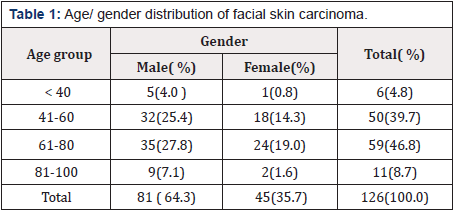
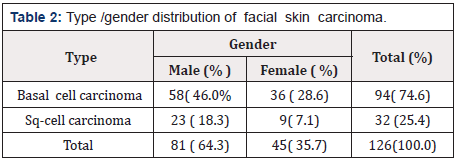
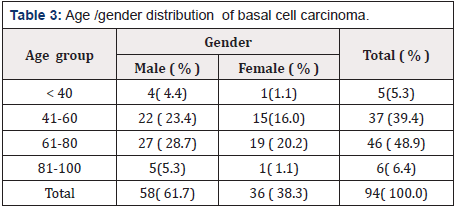

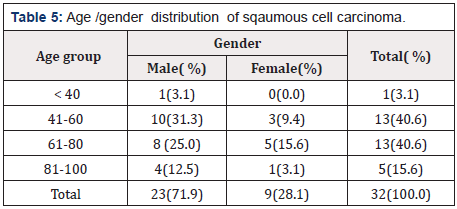
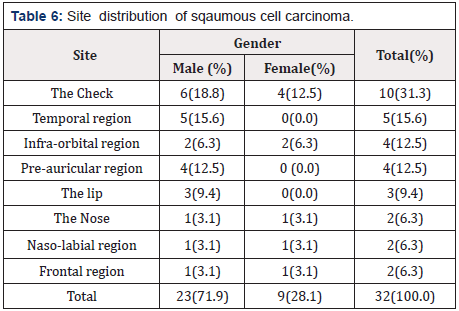
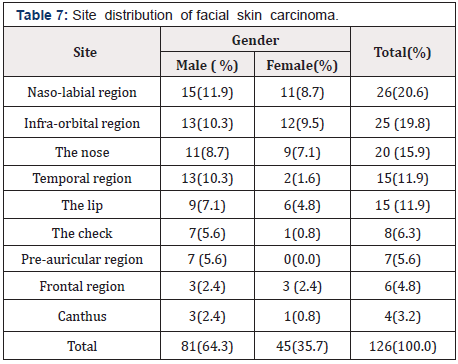

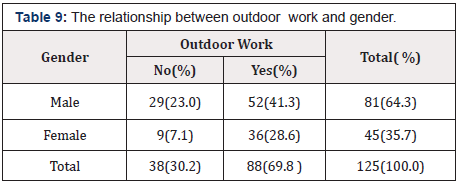




 We use cookies to ensure you get the best experience on our website.
We use cookies to ensure you get the best experience on our website.